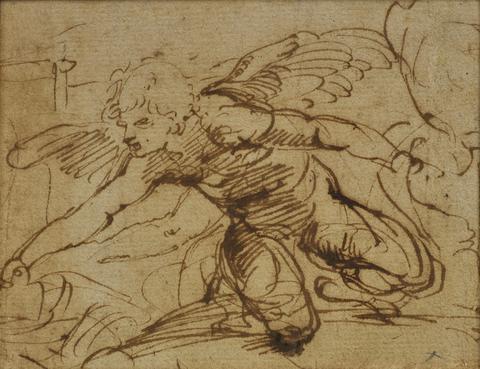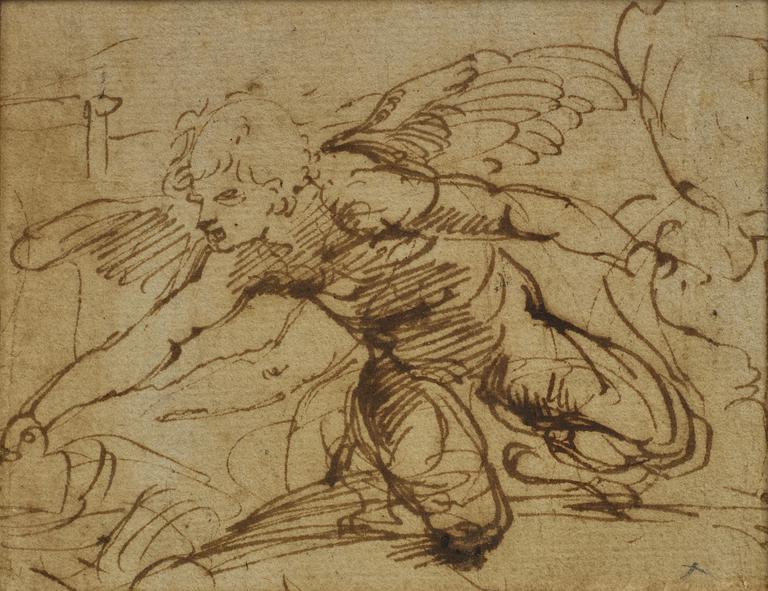
Ange
Agostino Carracci (attribué à) (1557 Bologne - 1602 Parme)
1590 (vers)
Plume et encre brune ; 7,5 x 9,5 cm
Provenance :
Londres, collection John Charles Robinson (Lugt 1433) ; Royaume-Uni, collection Lady Ottoline Morrell ; Cirencester, Dominic Winter Auctions, 29 juin 2016 ; Uzès, Ribière & Associés, 12 mai 2019 ; Paris, collection Le Polyptyque ; Paris, collection privée.
Bibliographie :
Catherine Loisel, Inventaire général des dessins italiens du Musée du Louvre, Ludovico, Agostino, Annibale Carracci, tome 7, Paris, Réunion des Musées Nationaux, 2004.
Ce dessin est évidemment un fragment d’une feuille plus grande, une « première pensée » pour une scène qui comportait, en haut à droite, l’ange : peut-être une Annonciation, ou les Saintes Femmes au tombeau du Christ.
Il frappe par son extrême énergie. Cet ange ne participe pas simplement du décor, mais à l’action même. Il y a de la précipitation, mais aucune hésitation, quitte à en paraître brouillon – ce qu’il est, en un sens.
Plutôt qu’à Annibale Carracci, auquel il était naguère attribué, c’est à son frère Agostino que nous proposons d’attribuer ce dessin. Son énergie précisément, tout en obliques et en extensions, évoque les compositions de Tintoret, dont certaines furent gravées par Agostino dans les années 1580 à Venise ; avec un tel succès que, s’il faut en croire Malvasia, premier biographe des Carracci, Tintoret se serait exclamé « qu’il en savait plus que lui ». On y retrouve aussi le graphisme « parfois imprévisible », comme l’écrit joliment Catherine Loisel, d’Agostino, le trait de plume fortement appuyé, les hachures et les zig-zags, le nez pointu, les orbites enfoncées, la chevelure résumée à quelques mèches, caractéristiques des années 1590.
Agostino Carracci, longtemps resté dans l’ombre de son frère Annibale et de son cousin Ludovico, n’en était pas moins la tête pensante de ce trio qui, parallèlement à Caravage, révolutionna la peinture italienne autour de 1600, d’abord à Bologne dont ils étaient natifs, puis à Rome. Mais il s’est d’abord consacré à la gravure, il est mort le premier, il n’avait pas le charisme de son cadet. Ce n’est que depuis les années 1990 qu’on réévalue son rôle et qu’on lui réattribue des dessins longtemps considérés comme d’Annibale ou de l’atelier.
Ottoline Morrell, dont les descendants conservèrent ce dessin jusqu’en 2018, était l’aristocrate du Bloomsbury Group, amie et mécène de ce groupe d’artistes et d’écrivains non-conformistes du début du 20ème siècle, qui l’intéressaient infiniment plus que son milieu d’origine (elle était la demi-sœur du sixième duc de Portland). Sans doute avait-elle rencontré John Charles Robinson, le précédent propriétaire, sur la côte du Dorset où le groupe prenait ses quartiers d’été de 1909 à 1912, et où lui-même s’était retiré, après avoir fondé ce qui devint le Victoria and Albert Museum, et occupé jusqu’en 1901 le poste de Surveyor of the Queen’s Pictures. « Il était – écrit Frits Lugt – un des connaisseurs les plus sagaces et les plus érudits de son époque ».
